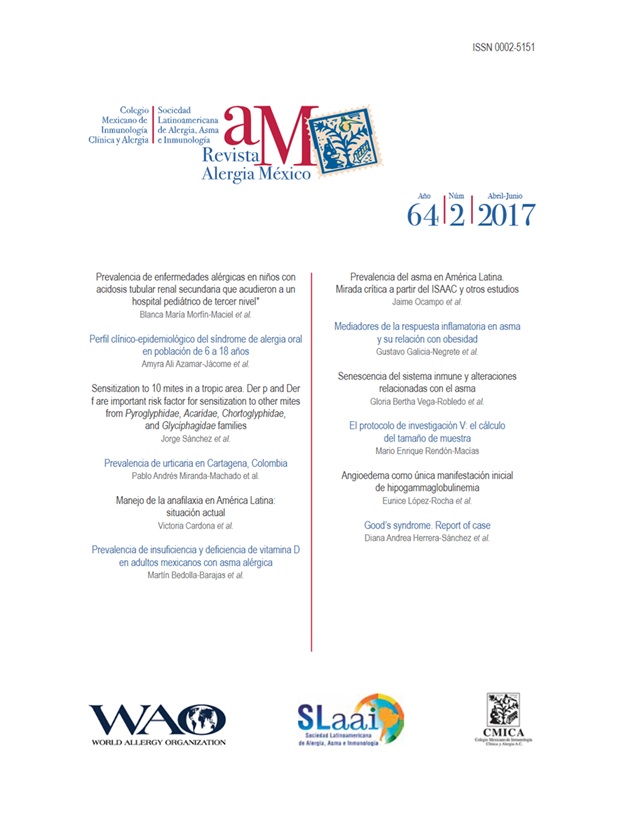Resumen
Introducción: El síndrome de Good es una asociación de timoma e inmunodeficiencia. Los síntomas son infecciones sinopulmonares recurrentes, además de los provocados por la compresión del timoma. Los exámenes paraclínicos se caracterizan por ausencia o disminución de linfocitos B, hipogammaglobulinemia, inversión de la relación CD4/CD8 y respuesta proliferativa anormal a mitógenos.
Caso clínico: Mujer de 49 años de edad con edema de miembros inferiores, vómito posprandial, disfagia, diarrea crónica y pérdida ponderal. Con una segunda endoscopia se descartó cáncer gástrico. En la placa de tórax se observó ensanchamiento de mediastino y en la tomografía toracoabdominal, derrame pleural bilateral y tumor en mediastino anterior. El reporte histopatológico fue timoma B1. Exámenes paraclínicos: IgG, IgA e IgM de 349, 70.3 y 37.1 mg/dL, respectivamente; Ca125 631 UI/mL, leucocitos 7890 mm3, hemoglobina 13.2 g/dL, linfocitos 2060 mm3; CD16+CD56+, CD19, CD3, CD4 y CD8 de 122, 77, 2052, 977 y 998 cel/µL, respectivamente; relación CD4/CD8 0.98; panel viral para hepatitis C, B y VIH negativo. La hipogammaglobulinemia confirmó síndrome de Good; se inició con 1 g/kg de gammaglobulina intravenosa, alcanzando meta de reemplazo a la tercera dosis, con mejoría clínica. La paciente falleció a los 4 meses por complicaciones cardiacas.
Conclusiones: A pesar de la variabilidad de la presentación del síndrome de Good, debe sospecharse como parte de las manifestaciones paraneoplásicas del timoma.
Referencias
Joven MH, Palalay MP, Sonido CY. Case report and literature review on Good’s syndrome, a form of acquired immunodeficiency associated with thymomas. Hawaii J Med Public Health. 2013;72(2). Disponible en: https://www.ncbi.nlm.nih.gov/pmc/articles/PMC3585500/
Kelesidis T, Yang O. Good’s syndrome remains a mystery after 55 years: A systematic review of the scientific evidence. Clin Immunol. 2010;135(3):347-363. DOI: http://dx.doi.org/10.1016/j.clim.2010.01.006
Kelleher P, Misbah SA. What is Good’s syndrome? Immunological abnormalities in patients with thymoma. J Clin Pathol. 2003;56(1):12-16. DOI: http://dx.doi.org/10.1136/jcp.56.1.12
Qu J, Lü X, Gao Q, Zhang Y. Good Syndrome: A rare cause of refractory chronic diarrhea and recurrent pneumonia in a Chinese patient after thymectomy. Clin Vaccine Immunol. 2013;20(7):1097-1098. DOI: http://dx.doi.org/10.1128/CVI.00141-13
Chen LP, Tsai JS, Lai WM, Yen LJ, Yu MS, Lin SJ. Myelodysplasia followed by Good’s syndrome: A unique manifestation associated with thymoma. Kaohsiung J Med Sci. 2012;28(4):236-240. DOI: http://dx.doi.org/10.1016/j.kjms.2011.10.012
Sáenz-Cuesta M, Martínez-Pomar N, de-Gracia J, Echaniz P, Villegas E, Prada A, et al. TACI mutation in Good’s syndrome: In search of a genetic basis. Clin. Immunol. 2012;145(1):27-30. DOI: http://dx.doi.org/10.1016/j.clim.2012.07.014
Ternavasio-de la Vega H, Velasco-Tirado V, Pozo-Rosado V, Soler-Fernández MF, Pérez-Andres M. Persistence of immunological alterations after thymectomy in Good’s syndrome: A clue to its pathogenesis. Cytometry Part B 2011;80B:339-342. DOI: http://dx.doi.org/10.1002/cyto.b.20595
Wang CH, Chan ED, Perng CL, Chian CF, Chen CW, Perng WC, Su WL. Intravenous immunoglobulin replacement therapy to prevent pulmonary infection in a patient with Good’s syndrome. J Microbiol Immunol Infect. 2015;48(2):229-232. DOI: http://dx.doi.org/10.1016/j.jmii.2012.09.003
Yong P, Chee R, Grimbacher B. Hypogammaglobulinemia. Immunol Allergy Clin N Am. 2008;28(4):691-713,vii. DOI: http://dx.doi.org/10.1016/j.iac.2008.06.003.
Frieri M, Good’s syndrome, CVID, and selective antibody deficiency in patients with chronic rhinosinusitis. Curr Allergy Asthma Rep. 2014;14(6):438. DOI: http://dx.doi.org/10.1007/s11882-014-0438-4
Rawat A, Dhir V, Grupta A. Good’s syndrome presenting with recurrent giardiasis. J Clin Immunol. 2014;34(7):751.

Esta obra está bajo una licencia internacional Creative Commons Atribución-NoComercial 4.0.
Derechos de autor 2017 Revista Alergia México





